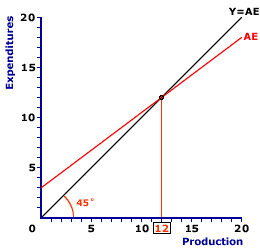
|
|
KEYNESIAN THEORY: A theory of macroeconomics developed by John Maynard Keynes built on the proposition that aggregate demand is the primary source of business cycle instability, especially recessions. The basic structure of the Keynesian theory of economics was initially presented in Keynes' book The General Theory of Employment, Interest, and Money (1936).
Visit the GLOSS*arama
|
|


|

|
                           KEYNESIAN CROSS: A diagram illustrating the basic Keynesian theory of macroeconomics, with aggregate expenditures measured on the vertical axis and aggregate production measured on the horizontal axis, with the relation between aggregate expenditures and aggregate production represented by a positively-sloped aggregate expenditures line. The "cross" aspect of this diagram is the intersection between the aggregate expenditures line and a 45-degree line indicating every point of equality between aggregate expenditures and aggregate production. The "Keynesian" aspect of this diagram is derived from John Maynard Keynes, the developer and namesake of Keynesian economics. Keynesian cross is a somewhat dated and seldom used reference to the standard Keynesian economics diagram relating aggregate expenditures and aggregate production. This diagram is also commonly referred to as the Keynesian model, the aggregate expenditures model, or the income-expenditures model. The term, Keynesian cross, pays tribute to John Maynard Keynes, the economist responsible for developing this macroeconomic theory in the 1930s. It also provides contrast with another fundamental economic diagram, the Marshallian cross, which is another term for the standard market model diagram.| Keynesian Cross |  |
This exhibit illustrates the basic Keynesian cross diagram. The vertical axis measures aggregate expenditures. The horizontal axis measures aggregate production. The red positively-sloped line, AE, represents the relation between aggregate expenditures and aggregate production. The slope of the AE line is positive, but less than one. The black positively-sloped line, Y=AE, is an equilibrium guide line that indicates all points in the diagram in which aggregate production is equal to aggregate expenditures. The slope of this Y=AE line is positive and equal to one. It is also termed a 45-degree line because it exactly bisects the 90-degree angle formed by the vertical and horizontal axes, creating a 45-degree angle with either axis.The AE line is the combined expenditures of the four macroeconomic sectors--consumption expenditures, investment expenditures, government purchases, and net exports. The slope of the AE line is primarily attributable to the slope of the consumption function, which is the marginal propensity to consume. The slope, however, is modified somewhat by induced investment, induced government purchases, and induced imports. Even with this adjustments, the slope is still positive and less than one. The intersection of the AE line and the 45-degree at $12 trillion in this exhibit is the Keynesian equilibrium. This is the value of aggregate production in which aggregate expenditures are exactly equal to aggregate production. Given the existing AE line, no other level of aggregate production achieves equilibrium equality between expenditures and production. Should the AE line shift up or down, then a new level of aggregate production achieves equilibrium. An important, but not readily apparent, implication of the Keynesian cross is that equilibrium does not necessarily correspond to the full employment of resources. In this exhibit, $12 trillion of aggregate production may or may not achieve full employment. More to the point of Keynesian economics, there is no reason to think that this equilibrium level of aggregate production NECESSARILY achieves full employment.

Recommended Citation:KEYNESIAN CROSS, AmosWEB Encyclonomic WEB*pedia, http://www.AmosWEB.com, AmosWEB LLC, 2000-2024. [Accessed: April 28, 2024].
Check Out These Related Terms... | | | | | | | | | | |
Or For A Little Background... | | | | | | |
And For Further Study... | | | | | | | | | |
Search Again?
Back to the WEB*pedia
|



|

|
ORANGE REBELOON
[What's This?]
Today, you are likely to spend a great deal of time searching for a specialty store trying to buy either a rechargeable battery for your computer or shoe laces for your snow boots. Be on the lookout for gnomes hiding in cypress trees.
Your Complete Scope
This isn't me! What am I?
|

|
|
The portion of aggregate output U.S. citizens pay in taxes (30%) is less than the other six leading industrialized nations -- Britain, Canada, France, Germany, Italy, or Japan.
|

|
|
"The roots of education are bitter, but the fruit is sweet." -- Aristotle
|

|
TIFFE
Tokyo International Financial Futures Exchange (Japan)
|

|
|
Tell us what you think about AmosWEB. Like what you see? Have suggestions for improvements? Let us know. Click the User Feedback link.
User Feedback
|


|


